Installing Downspout Drain Lines
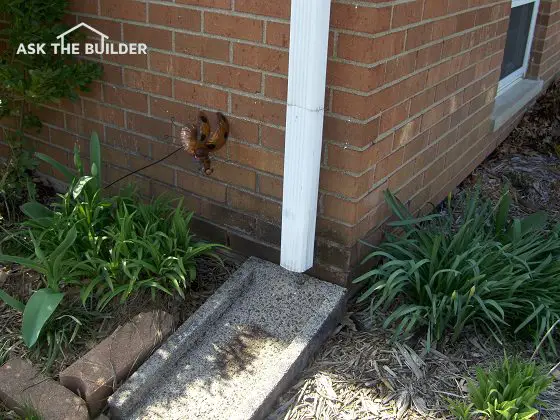
Install Downspout Drain Lines | Splash blocks don't do much to channel water away from the foundation. © 2022 Tim Carter
Install Downspout Drain Line TIPS
- Use solid SDR-35 PVC pipe
- Use only 45 or 22.5-degree bends underground
- Call 811 to locate underground utilities
- Don't put pipes in un-compacted fill dirt
- CLICK HERE to Get Tim's FREE & FUNNY Newsletter
Ethel had a flooding disaster similar to Rich's issues. Check out the May 21, 2020 Newsletter to read her story.
DEAR TIM: I need to bury downspout drainage pipes in my yard before the yard is seeded. Where is the best place to put them and how deep should they be buried? What type of pipe do you like? How far away from the house should the pipes extend? A friend suggested using pop-up valves to help water the lawn and plants. Are those a good idea? Rich T., Jackson, MS
DEAR RICH: Stormwater drainage from roofs is a topic sometimes ignored by builders and homeowners alike. I can't tell you how many houses I see where the downspouts empty onto a splash block at the base of the foundation.
CLICK HERE to get FREE & FAST BIDS from local landscapers who can install downspout drain lines.
Often these homeowners are plagued with water seepage into basements or crawlspaces and it's no wonder. Heavy rainfall on an average-sized roof can produce hundreds and thousands of gallons of water that spew from the different downspouts located around the house.
Read another column of mine about downspout drain lines that shows you how much water can come off a roof in as moderate rainfall. You'll be AMAZED!
Harvest Rainwater
I regularly visit the Southwestern part of our great nation and am somewhat astonished that stormwater is not collected and stored by homeowners that live in this arid area. Laws passed decades ago often prevent homeowners from harvesting and storing water that falls on their land. River systems that feed into the Colorado River are affected by this because the water in this drainage basin eventually flows to and through the Hoover Dam.
The water held back by this dam is used to irrigate crops grown for many people in the USA. The water also makes electricity that's sent to tens of millions in southern California and other parts of the Southwest. It's a complex situation.
If you're permitted to collect and store rainwater, this water can be easily collected and piped to above or below ground plastic barrels or tanks. If the storage is above-ground and placed at the highest part of the lot, drip irrigation piping can be extended from the water storage.
The stored rainwater can then be used to help irrigate plants that otherwise would have enjoyed the drink before the house was built.
A simple phone call to your local town office will allow you to discover if you're permitted to harvest rainwater.
Why No Harvesting
The issue with harvesting rainwater is that it lowers the cubic-feet-per-minute of flow in the major rivers. If you collect the rainwater and then use it to water plants, drink and then put back into the earth via your septic system, that water never makes it into the river and then down to the large dams.
Contracts negotiated decades ago count on the water making it to the dams. The entire water-rights issue on private land in the Western USA is very complex. It's far beyond the scope of this column.
Urban Storm Sewers
Before you proceed with any work, you should check with your local government to see if they have special stormwater rules and regulations. Sometimes you have to pipe this water to special underground storm sewers or above-ground channels. Some local governments or agencies have no rules or regulations.
Trenching Tools
I usually dig a trench about 12 to 14 inches deep for downspout drain lines. The fastest way is to rent a trenching machine from a local tool rental.
If you have hard clay soil, or rocky soil, you can use an electric hand-held demolition hammer tool to dig a trench.
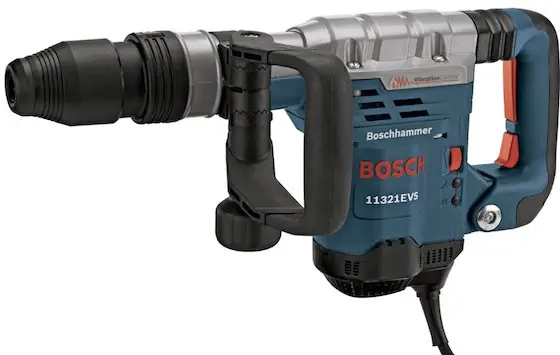
This is a great demolition hammer tool to chip out rotten concrete. If you've got a bigger job that's going to last a few days, you should BUY one, keep it in good shape and then SELL it on Craigslist once done. This will be cheaper than renting one. BUY THIS GREAT POWER TOOL right here. I own one just like it.
These electric demolition tools can be outfitted with chisel tips to crack larger rocks or clay spade shovel tips to carve through dry or damp clay soil.
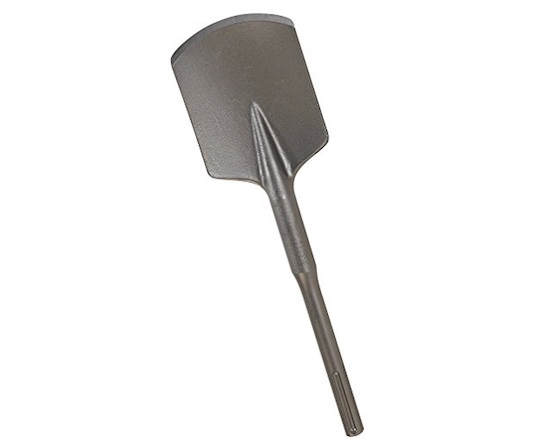
This is a miniature shovel that fits on the end of the Bosch demolition hammer. It carves through clay soil like a hot knife through cold butter. BUY THIS FANTASTIC ACCESSORY right here.
If the lot is fairly flat, the pipes will get deeper the farther they extend as you should create 1/8 inch of fall for every foot the pipes run. The pipes should never be buried running parallel in the non-compacted fill dirt that is placed against the foundation.
CLICK HERE to get FREE & FAST BIDS from local landscapers who can install downspout drain lines.
Over time this dirt or soil settles and it can cause piping to break, kink or develop reverse, or backwards, slope.
Downspout piping can cross the un-compacted fill at a 90-degree angle so that it is placed in undisturbed soil. But as the soil adjacent to the house settles over time, this small length of piping needs to be checked and lifted to ensure it drains.
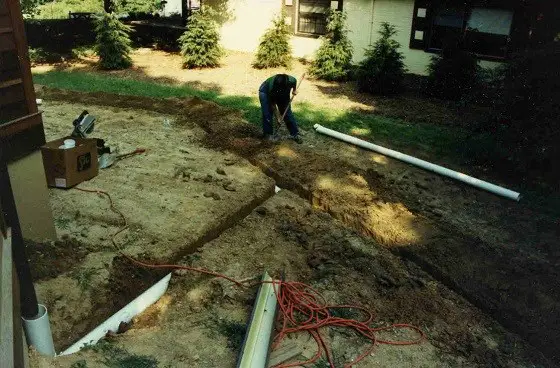
The pipe in the lower left of the photo is crossing an un-compacted fill around the basement of my house. I allowed the fill to settle for months and watered it before installing the downspout drain lines. The pipe is 4-inch SDR-35 and it intersects the other pipe farther in the yard using a standard wye fitting. (C) Copyright 2017 Tim Carter
SDR-35 Pipe And Fittings
A smooth 4-inch-diameter plastic SDR-35 sewer pipe is the material I prefer to use. This pipe has a smooth interior and closely resembles the thick-walled plastic piping used for interior house drain and vent piping.
Fittings can be permanently welded to the pipe with PVC cement. These fittings come in all types including the all-important Wye fitting where one pipe connects to another.
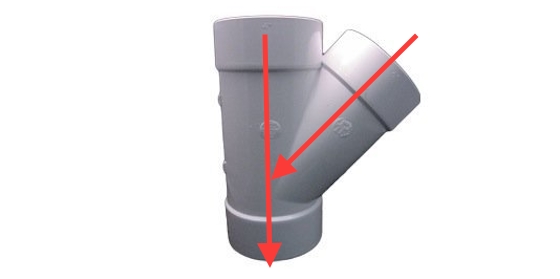
This is a standard Wye fitting. Note the red arrows that show you the direction of water flow through the fitting. BUY THIS WYE FITTING HERE NOW.
If you don't want to use glue, you can buy rubber-gasketed fittings. These fittings have a rubber o-ring incorporated into each end of the fitting.
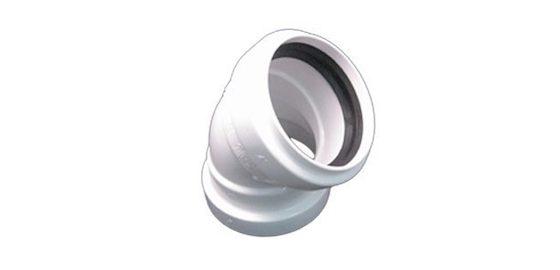
This is a gasketed 45-degree SDR-35 fitting. Note the black gasket. You use lots of these. All underground bends need to be 45 degrees. If you need to make a 90-degree bend underground, you should use two 45 bends and put a 1-foot piece of pipe in between them. You do this so it's easier to get a drain-cleaning snake through the pipe if it ever gets clogged. BUY THIS FITTING HERE now.
You need to keep the pipe clean of all sand and dirt when you work with gasketed fittings. You also need to use a coarse file to taper the cut ends of any pipe. If you don't file the ends, you'll never slide the pipe into the rubber gasket. You also lubricate the pipe and gasket with liquid dish soap.
If you install either type as directed, tree roots that create clog nightmares will never be able to enter the piping system. I am not a huge fan of the corrugated flexible black piping for downspouts. It can crush easily and it is nearly impossible to clean with professional drain cleaning equipment.
All underground bends in downspout piping should be made with 45 degree or smaller angle fittings. Ninety-degree angles underground become obstacles in the event the piping has to be cleared by a professional drain cleaning company.
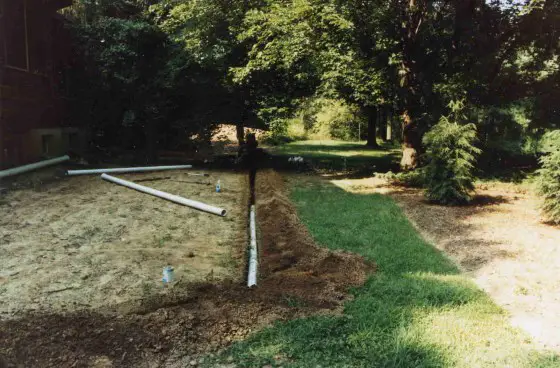
The downspout drain line had to make a bend. In the lower part of the photo, the pipe you see connects to a 45-degree fitting. - © 2017 Tim Carter
You can use a 90-degree angle at the base of the downspout where the underground piping begins, as a drain cleaner can usually insert his metal snake here with no difficulty.
Pipe Away From House
If you are allowed to drain your stormwater on your own lot, do so as far away from your home as possible. Try to pipe all water to a low point away from your home.
Don't drain more water to a point on your lot than would have ended up there naturally before your home was built. Simply keep in mind where the water is falling on the roof and where that water would drain if your house had never been built. If you pipe the water where it used to go, you should not harm any of your surrounding neighbors.
Pile Up Rocks
Where the downspout drain line terminates above ground, it's going to cause erosion because you're concentrating lots of water from your roof at this point. Create a large area of softball-sized rocks that the water will flow onto. This absorbs some of the energy and spreads out the water.
Inline popup valves do a good job of allowing rainwater to discharge onto your property, so long as you are allowed to drain the stormwater on your property. Try to strategically place them where they will do the most good for your vegetation.
Photographs & Videos
An invaluable tool that will come in handy in future years is a collection of photos and videos that are shot as the downspout piping is being installed. Videos are best because you can talk and describe what the camera is seeing. Upload these to cloud storage and pass them onto the future buyer of your home.
If you stand back and include parts of the house in the photos and place shovels or other objects in the photos for scale, these prints will help you locate the pipes in the future. Over time it is very easy to forget where hidden pipes pass in the ground.
My own photos saved me lots of work in the past. I had to install a small field drain in a side yard. The photos I had taken years before allowed me to locate within five minutes the drainpipe to which the new drain was to be connected. I could have dug for an hour and missed the pipe by inches without the aid of the photographs.
CLICK HERE to get FREE & FAST BIDS from local landscapers who can install downspout drain lines.
Column 517
47 Responses to Installing Downspout Drain Lines